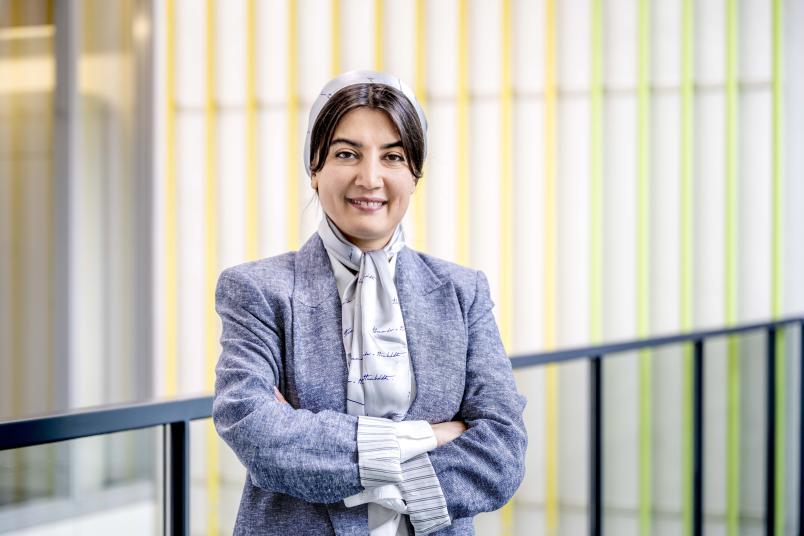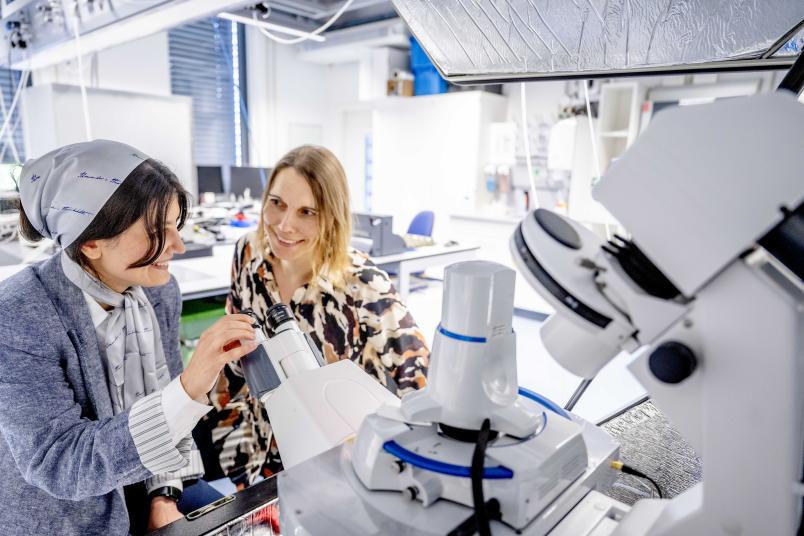
Naimeh Naseritaheri conducted research at Sharif University of Technology and at Monash University, before coming to Ruhr University as an Alexander von Humboldt Fellow.
Internationalization
“There’s a vibrant international and multicultural spirit here”
Naimeh Naseritaheri is an Alexander von Humboldt Fellow at the Chair of Analytical Chemistry II. Her research contributes to the global transition to renewable energies.
She has come all the way from Melbourne to Bochum: Naimeh Naseritaheri has been awarded an Alexander von Humboldt Fellowship to conduct research at the Chair of Professor Kristina Tschulik at Ruhr University Bochum. In this interview she gives insights into her fascinating research and its long-term benefits for society, while also sharing her experiences as an academic visitor. Spoiler: Naseritaheri is full of praise for her host institution, the scientific synergies and the warm and vibrant atmosphere here on campus. Thus it comes as no surprise: Naseritaheri will be back next year to continue her research stay. We are already looking forward to welcoming you back!
Naimeh Naseritaheri, what is your research about?
My research focuses on engineering advanced nanostructures for photo/electrochemical reactions. This includes passivated semiconductor interfaces, two-dimensional layered materials and hierarchically structured, printable architectures with applications spanning solar hydrogen production, energy storage, and chemical sensing. Over the last years, I have increasingly focused on preserving and enhancing the functionality of these materials for more scalable, real-world applications.
What do you find most exciting about researching these materials?
What I find most exciting about applied physical research is the opportunity to bridge fundamental scientific understanding with practical solutions, that is bringing advanced materials closer to everyday use.
You are referring to the “everyday use”. Can you elaborate on this? How does your research benefit society?
My research broadly contributes to securing clean and sustainable energy resources for the future. By developing advanced functional materials, we aim to enable technologies that reduce environmental impact and support the global transition to renewable energy. For example, my work on semiconductor design for solar hydrogen production draws inspiration from natural photosynthesis, often termed artificial photosynthesis, to produce hydrogen fuel from sunlight and water.

This offers a promising pathway to generate carbon-free energy and support a greener, more sustainable energy system.
This offers a promising pathway to generate carbon-free energy and support a greener, more sustainable energy system. Or imagine being able to simply print the small-scale devices you need for everyday life – from flexible sensors to micro-sized batteries. This is another frontier I’m actively exploring: the design of functional materials with tailored fluidity and rheological properties to enable scalable, high-throughput printing. Such simplicity and scalability in device fabrication could democratize technological innovation by making low-cost, accessible products widely available.
What research project are you working on, while here at Ruhr University?
One of the fundamental questions in materials research – before scaling up to ensembles of particles – is understanding the intrinsic properties and electrochemical behavior of materials at the micro- to nanoscale, and sometimes even at the single-particle level. To address this, fascinating methodologies have been developed to precisely probe the characteristics of nanomaterials during targeted electrochemical reactions.

Together, we aim to gain knowledge that is essential for designing more efficient and scalable materials systems.
Here at Ruhr University Bochum, I’m working in collaboration with Kristina Tschulik and her NanoEC research team. Tschulik is a pioneer and internationally recognized expert in this field, particularly known for advancing techniques such as nanoimpact electrochemistry and scanning electrochemical probe microscopy techniques. Together, we aim to gain mechanistic insights into how individual particles behave and contribute to overall functionality – knowledge that is essential for designing more efficient and scalable materials systems.
Why did you choose Bochum?
One of the biggest reasons I chose Bochum was the chance to work with Tschulik. I had been following her research for a while and was genuinely inspired by the innovative work coming out of her group. She’s very well-known in the field, and the idea of learning from and collaborating with her felt like a rare and exciting opportunity.

I’ve really enjoyed the experience – both the work and the welcoming, down-to-earth vibe of Bochum.
At the same time, I was also drawn to the strong interdisciplinary culture at Ruhr University Bochum and the very open, collaborative research environment here in Germany. Since arriving, I’ve really enjoyed the experience – both the work and the welcoming, down-to-earth vibe of Bochum itself.
What struck you in particular during your stay?
At work, what I find particularly remarkable is the leadership of my host, Kristina Tschulik. She brings a rare combination of scientific depth, creative thinking, and mentorship. Her ability to guide complex research while also being closely involved in technical discussions is truly inspiring.

Collaborating for new ideas: Humboldt Fellow Naimeh Naseritaheri (left) from Monash University and Kristina Tschulik (right), Chair of Analytical Chemistry II at Ruhr University Bochum.
She is often the source of key ideas that help us overcome experimental challenges, and she fosters an open, supportive environment where everyone feels encouraged to contribute. The NanoEC team reflects this spirit – collaborative, high-energy, and full of mutual respect – which makes working here both productive and fulfilling.

Outside of work, what’s really stood out to me is how welcoming everyone has been.
Outside of work, what’s really stood out to me is how welcoming everyone has been – from colleagues to people in the city. There’s a vibrant international and multicultural spirit here, which I didn’t fully expect but truly appreciate. It’s made settling in much easier. I also enjoy the overall balance – you can focus deeply on your research while still having space to pause, reflect, and enjoy your surroundings.
What is your favorite place on campus?
One of my favorite places on campus is the Botanical Garden, which is actually just a short walk from our lab. It’s a peaceful spot where I can take a break, enjoy the greenery, and listen to the birds – such a nice contrast to the lab environment and a great way to clear my mind. I’ve also heard there’s an art museum on campus with the largest collection of ancient art in the Ruhr area. I haven’t had the chance to visit yet, but it’s definitely on my list.

One moment that really stood out for me was attending the PhD defense of one of the NanoEC team members.
One moment that really stood out for me was attending the PhD defense of one of the NanoEC team members – now officially Dr.! It was such a wonderful experience, not just the academic part but also the joyful traditions, celebrations, and the sense of community that came with it.
From what you have observed: What does Ruhr University Bochum stand for?
For me, Ruhr University Bochum stands for a place, where capable minds meet open hearts. It truly feels like a university built to change – and to help others change the world with it.

I look forward to building lasting partnerships and impactful research together.
I truly hope this fellowship leads to long-term collaboration with Kristina Tschulik and the fantastic colleagues at Ruhr University. The scientific synergy and supportive environment here have been incredibly motivating, and I look forward to building lasting partnerships and impactful research together.
